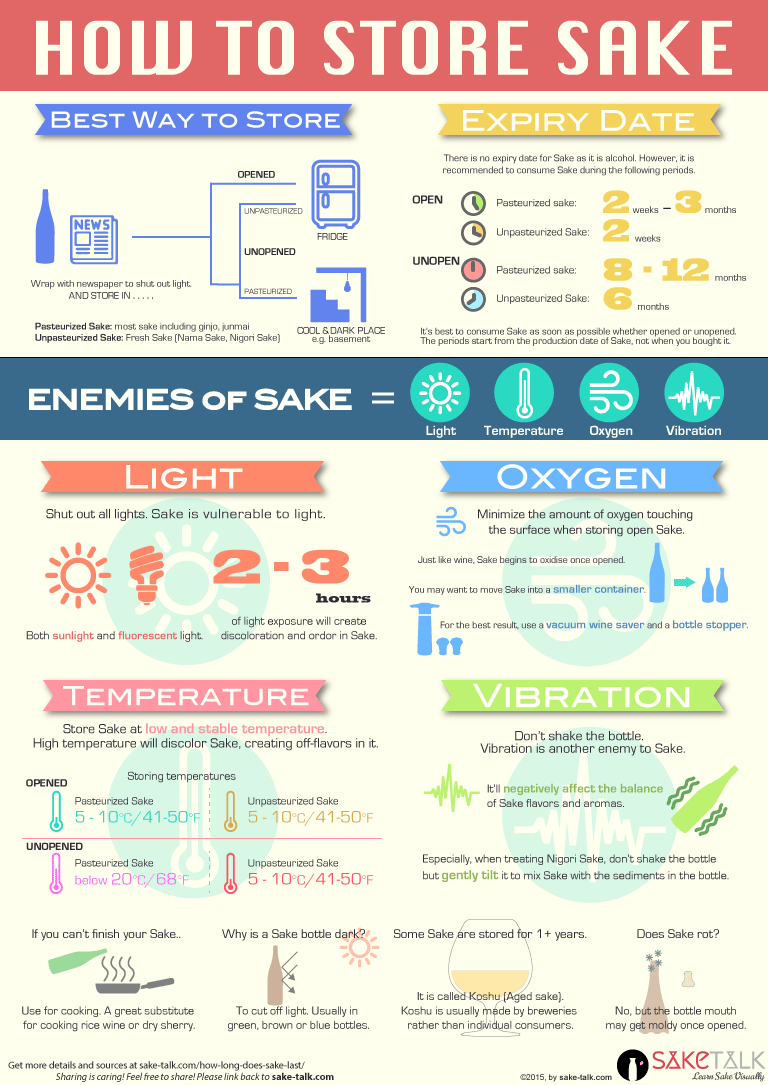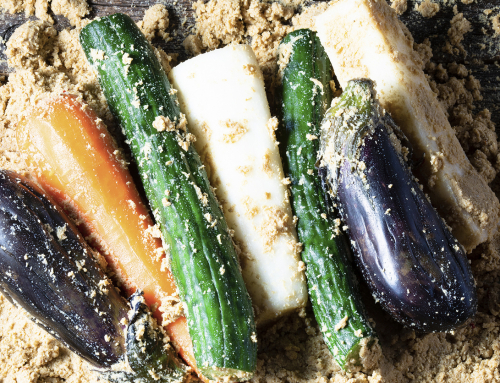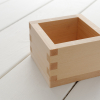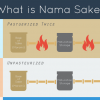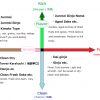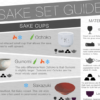Contents
Here, we’ll talk about two of the Sake FAQs – ‘How long does Sake last?’ and How to store Sake.
Learn them visually with the following infographic!
How Long Does Sake Last? Sake Expiry Date
Sake has no expiry date.
How long Sake lasts depends on types of Sake and whether the bottle is opened or not. First of all, there’s no expiry date for Sake. Theoretically, alcohol doesn’t rot. this is why there’s no expiry date shown on a Sake label.
Enjoy Sake ASAP
Despite no expiry date, Sake is best to consume as soon as possible. Sake is usually shipped from breweries when it’s in the best condition. Especially unpasteurized Sake like Nama zake and Nigori zake are to be consumed really ASAP. I treat this type of Sake like milk. Keep it in the fridge and enjoy it while it’s fresh.
How long pasteurized Sake can last depends on types of Sake. Ginjo Type and Junmai Type have shorter shelf life (8-10 months) than Honjozo Type (12 months) when unopen.
Shelf life of open pasteurized Sake also depends on types and is controversial. Some say a few weeks while others say a few months. Personally, my borderline is 1+ month. It just tastes differently. Lots of off-flavors, odors and acidity.
It’s not from when you bought it
Those recommended periods in the infographic don’t start from the purchase date. It’s from the production date of Sake. Production date (製造年月) is when Sake is made, and is shown on the label.
How you store Sake is more important
These periods are under condition that Sake is stored properly. Poor storage condition will shorten how long Sake lasts. Even within a few hours will ruin Sake taste. Sake is that delicate!
Let’s learn how to store Sake properly!
How to Store Sake
As shown in the infographic, Sake is vulnerable to light, temperature, vibration and oxydization (if opened). Thus:
The best way to store Sake = Wrap with newspaper + Fridge
Unopen pasteurized Sake (most types of Sake like Ginjo and Junmai) can be stored in a cool, dark place. Maybe the basement or a wine cellar.
Newspaper can be substituted with anything that wraps a Sake bottle and blocks out light.
If your fridge is rattling, you may want to thing of a better place. Also, the door pocket in a fridge is not recommended as the temperature is uneven.
Some Sake is aged for 1+ years
Aged Sake (Koshu), by definition, is Sake that has been aged in Sake breweries for 3+ years. (1-3 year old Sake is technically not ‘aged Sake’ but it exists in the market.) Aged Sake is brewed to be Aged Sake from the scratch and aged in the brewery under their intended storage condition.
Thus, most Aged Sake is born to be Aged Sake. It’s a bit tough to make it at home!
Can Sake Rot?
Theoretically, alcohol doesn’t rot. But if Sake is opened and germs and water are on the bottle mouth, the mouth can get moldy over time. Make sure you clean the bottle mouth and cap if you intend to store open Sake for a long period.
Having said that, most Sake is best to be consumed ASAP. Store it properly and enjoy Sake!

